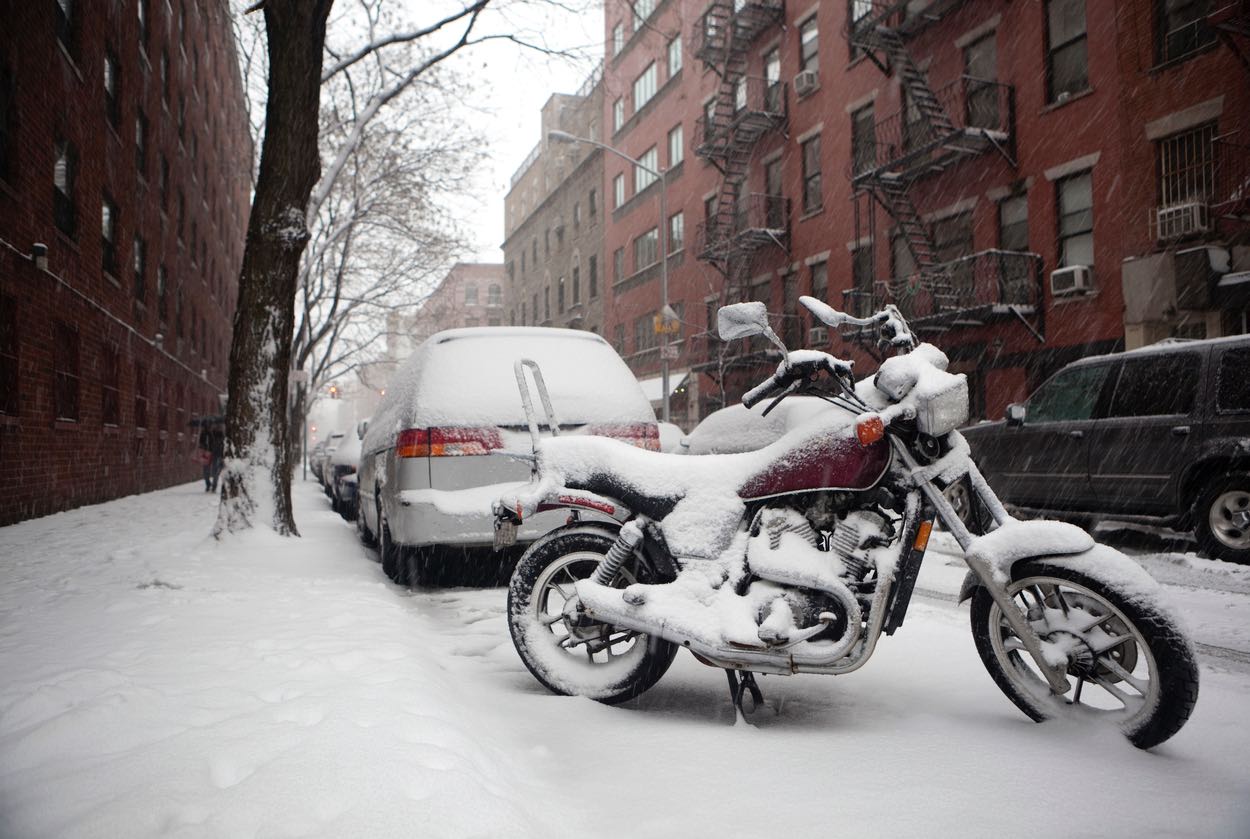Those who are passionate about motorcycles have the enormous challenge of safeguarding their valued rides as the crisp winter frost comes in. If you ignore your two-wheeled companion during these chilly months, they can sustain permanent damage. In order to ensure that your motorcycle comes out of storage in the spring just as beautiful as it did when it was originally hidden away, this comprehensive guide will walk you through all the necessary steps.
The routes less traveled beckon no more as winter spreads its icy blanket, signaling the end of the riding season for motorcyclists in the United States. If this time of idleness is not carefully monitored, it might be disastrous for your valuable motorcycle. Winterizing your bike is more than just keeping it stored away; it’s a way to get ready for spring. Protected from the harshness of winter, a well-kept motorcycle guarantees that you’re not simply chasing the first mild air but prepared to welcome it completely.
The winterizing procedures are essential for all motorcycle owners. They act as a defense against the creeping dangers of battery deterioration, engine corrosion, and rust. This is not just maintenance; it’s a custom that preserves the essence of motorcycling and makes sure that the bike comes out of its winter hibernation in perfect shape. This article explores extensively into the practice of winterization, outlining essential steps to protect the health, appearance, and functionality of your motorcycle so that come springtime, you and your ride will be prepared to embrace the open road with enthusiasm.
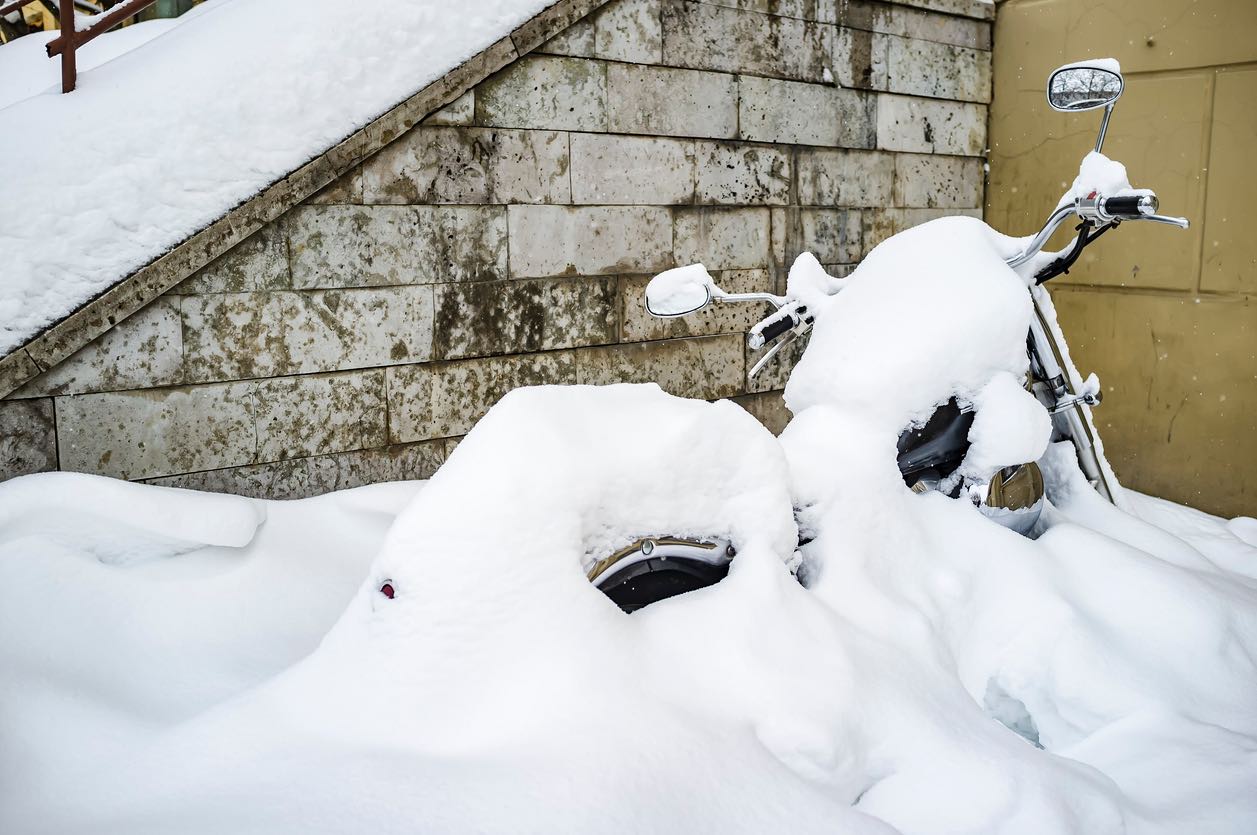
Fluid Check and Replacement
Engine oil, brake fluid, and coolant—your motorcycle’s lifeblood—need special care before storage. This is the perfect time to change the fluids on your motorcycle if they are due. But if they appear to be in good condition based on recent maintenance, don’t replace unnecessary fluids. Keep in mind that maintaining consistent fluid levels and quality is essential to keeping the engine and other systems of your motorcycle in top condition throughout the winter.
To get more technical, engine oil—which is sometimes disregarded—is essential for protecting your motorcycle’s engine in the winter. When the bike is left stationary for a long time, increased wear and friction from old or contaminated oil can be harmful. Replace the oil and oil filter on your motorcycle if it hasn’t had a lot of rides since the last oil change. This guarantees the best possible lubrication and gets rid of any impurities that might damage the engine’s internal components.
In a comparable way, coolant and brake fluid are essential to preserving the functionality of your motorcycle. Due to its hygroscopic nature, brake fluid has a tendency to absorb moisture over time, which can reduce its effectiveness and possibly cause corrosion in the braking system. Thus, these problems can be avoided by inspecting and, if required, replacing the brake fluid. On the other hand, in cold weather, the coolant is essential in keeping your engine from freezing. Make sure the concentration and level are appropriate to offer sufficient defense against freezing and corrosion. By being proactive, you’re not only extending the life of your motorcycle and getting it ready for riding in the coming season, but you’re also getting it ready for winter.
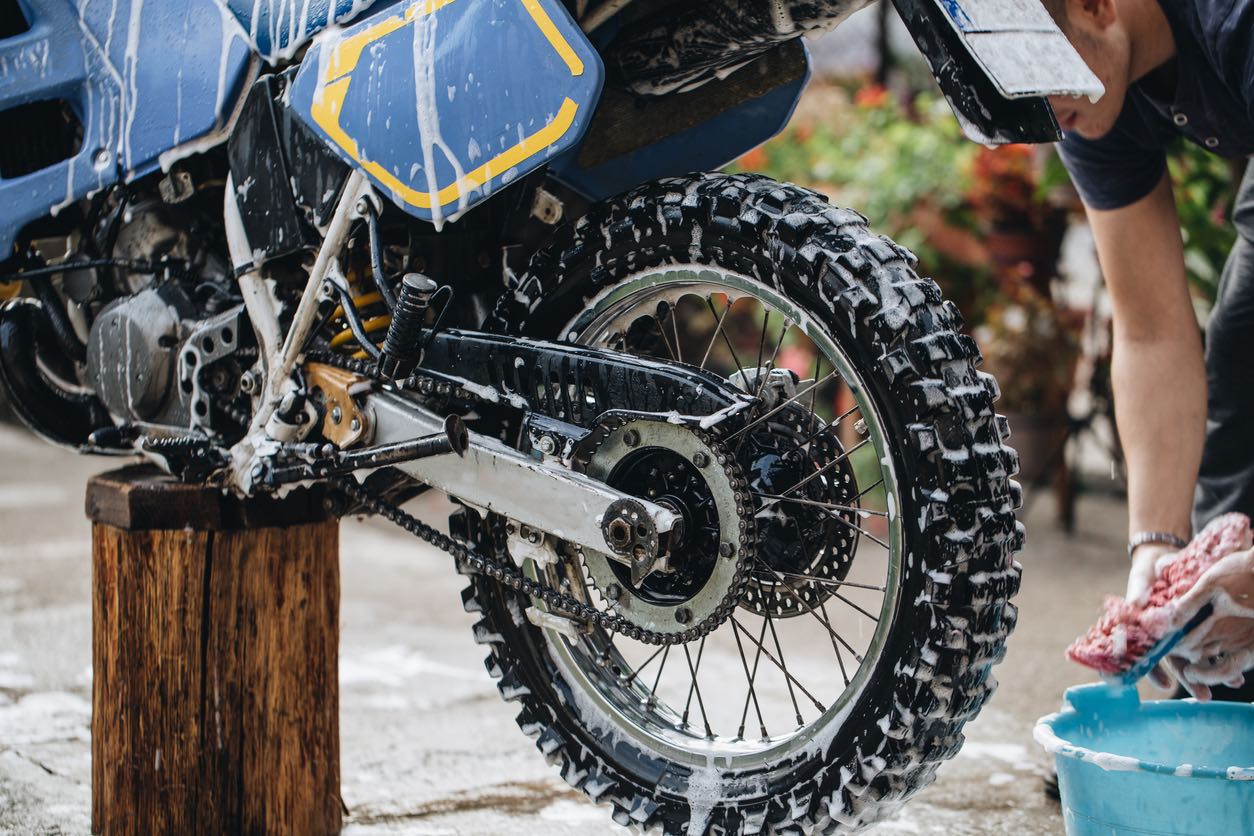
Maximizing Protection with a Detailed Cleaning Process
It’s essential to give your motorcycle a thorough wash, dry, and wax before storing it for the winter. As dirt and grime tend to collect most in the brakes and chain, start with the parts that are dirtiest. This first step makes sure that corrosive materials such as oil and road salt are removed, which can result in serious damage if neglected. Once these are taken care of, give the entire area a thorough wash. To gently yet thoroughly clean every surface, use a mild detergent made especially for motorcycles. This thorough cleaning is an essential part of long-term preservation, as well as improving the bike’s appearance.
Sealing in the Cleanliness with Wax
Drying is an important step that comes after washing. Be thorough and use microfiber towels to collect all moisture, especially from confined spaces. Rust and corrosion are mostly caused by moisture, and even a small amount of moisture left on the bike over time can cause serious harm. When the motorcycle is totally dry, apply a premium wax. This layer serves as a shield, keeping the dry and frigid winter storage conditions away from the spotless surface. This wax coat is essential for preventing rust and decay in addition to keeping the surface shiny. Regularly waxing your motorcycle before storing it for the winter can keep it looking good and prolong its life, so it’s a worthwhile step in any winterization process.
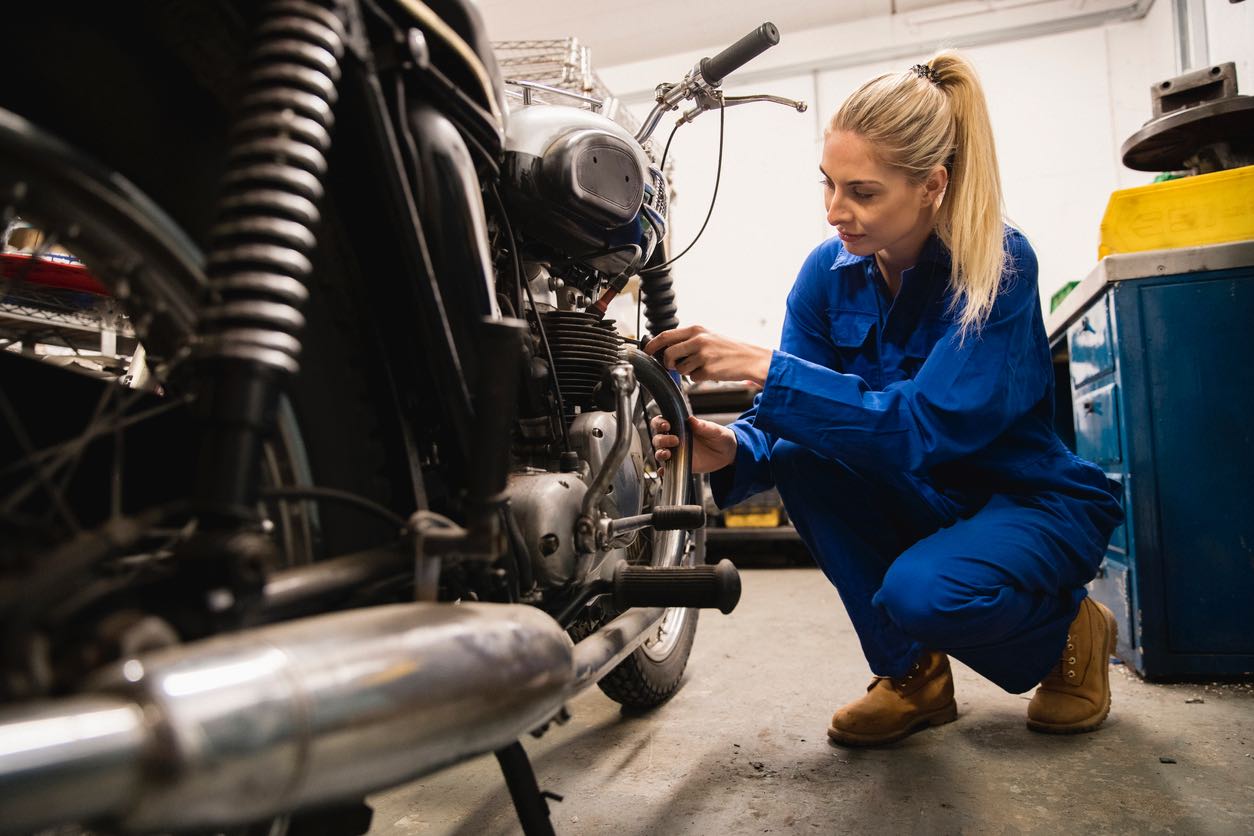
Ensuring Driveline Health
An essential part of winterizing your motorcycle is a comprehensive driveline inspection. In particular, the chain requires careful review. A chain that is correctly adjusted and lubricated in accordance with the manufacturer’s specifications not only increases performance but also prolongs its life. Regular upkeep here helps to avoid the rust and stiffness that can appear during the winter. Remember that both rider safety and smooth operation depend on a chain that is in good condition.
Those whose motorcycles have a differential or belt drive should also be as careful with these parts. It is important to check for general integrity, appropriate tension, and wear and tear. Following the detailed maintenance instructions provided by the manufacturer of your motorcycle will guarantee that these vital parts continue to operate safely and effectively. Ignoring this step can result in costly and potentially dangerous wear and potential failure. With this proactive approach to driveline maintenance, you can be sure that your motorcycle will be ready to go again as soon as spring arrives, with no unpleasant surprises.
Including these thorough procedures in your winterization process not only maintains your motorcycle in top condition but also adheres to industry best practices that are advised by both experts and motorcycle enthusiasts. Making the driveline on your motorcycle a priority is an investment in both the longevity of your vehicle and your enjoyment of it.
Fuel Stabilization Techniques for Optimal Winter Storage
An essential part of winterizing your motorcycle is treating the gasoline. Ignoring this can lead to fuel degradation, which could result in serious engine issues when you start your bike in the spring. Because of this accelerated degradation process in colder temperatures, fuel treatment is not only advised but absolutely necessary to maintain engine health. The first step in this process is to add a premium fuel stabilizer, which is a product that is easily found at most auto or motorcycle stores. The purpose of this additive is to prevent the deterioration of gasoline in your tank during the months when you are not using it.
The next important step is to completely fill your tank after adding the stabilizer. There is less space for air in a full tank, which reduces the buildup of moisture. Moisture within the fuel tank can cause rust, which can harm the fuel system permanently. It is imperative that you run the engine of your motorcycle for a few minutes after adding the stabilizer and filling the tank. By doing this, you can be sure that the stabilizer gets into every part of the fuel system and is fully mixed with the fuel. It’s an easy yet reliable method to ensure that the fuel system on your motorcycle stays optimally functioning all winter long, so it starts smoothly come springtime.
These are the steps to take in order to get your motorcycle ready for spring. Maintaining the engine and guaranteeing a pleasurable, trouble-free ride as soon as the weather permits are two goals of proper fuel care. Never forget that fuel treatment is an essential part of keeping your motorcycle’s engine in good working order.
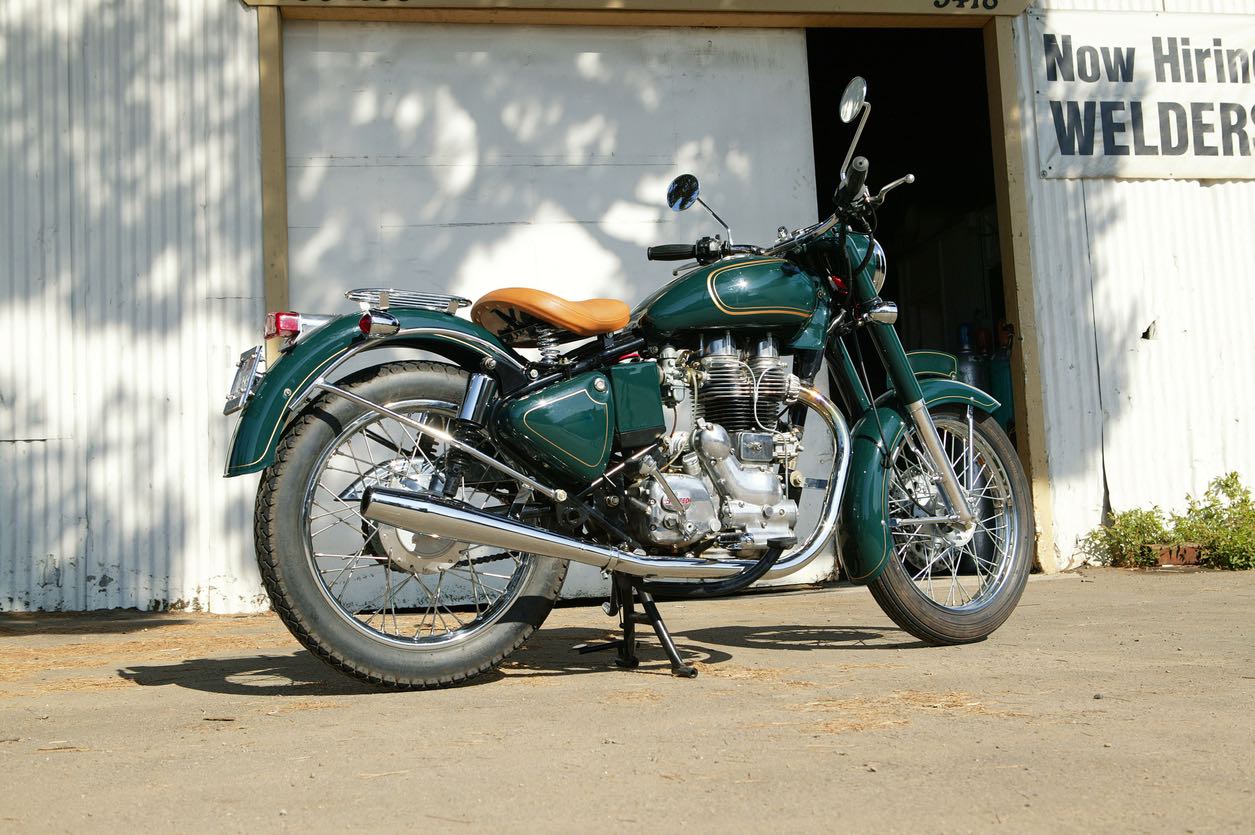
Protecting the Exhaust
For the exhaust system on your motorcycle to last as long as possible, it must be properly prepared for winter. Start by giving the exhaust a thorough cleaning to get rid of any dirt, grime, or salt residue, as stated in step 1 above, — common causes of corrosion and rust. Use a rust inhibitor, like WD-40, after cleaning, especially on chrome parts. The integrity of the exhaust must be preserved during the chilly, wet winter months by means of this protective coating, which serves as a barrier against moisture and corrosion.
Protecting the exhaust pipes from unwanted pests is just as important as preventing rust. During the winter, small animals and insects frequently take up residence in the warm confines of exhaust pipes, which can result in blockages or other damage. You can effectively deter these intruders by plugging the exhaust ends securely. Effective barriers can be made from everyday objects like rubber exhaust plugs or even a plastic bag that is tightly tied. By taking this easy but effective precaution, you can avoid future repair expenses and guarantee that your motorcycle’s exhaust system is in perfect working order for the upcoming riding season.
By putting these tactics into practice, you not only preserve the performance of the exhaust system but also enhance the general health of your motorcycle while it is stored for the winter. You can be sure that your motorcycle will be in excellent shape and ready for new adventures when the warmer weather returns.
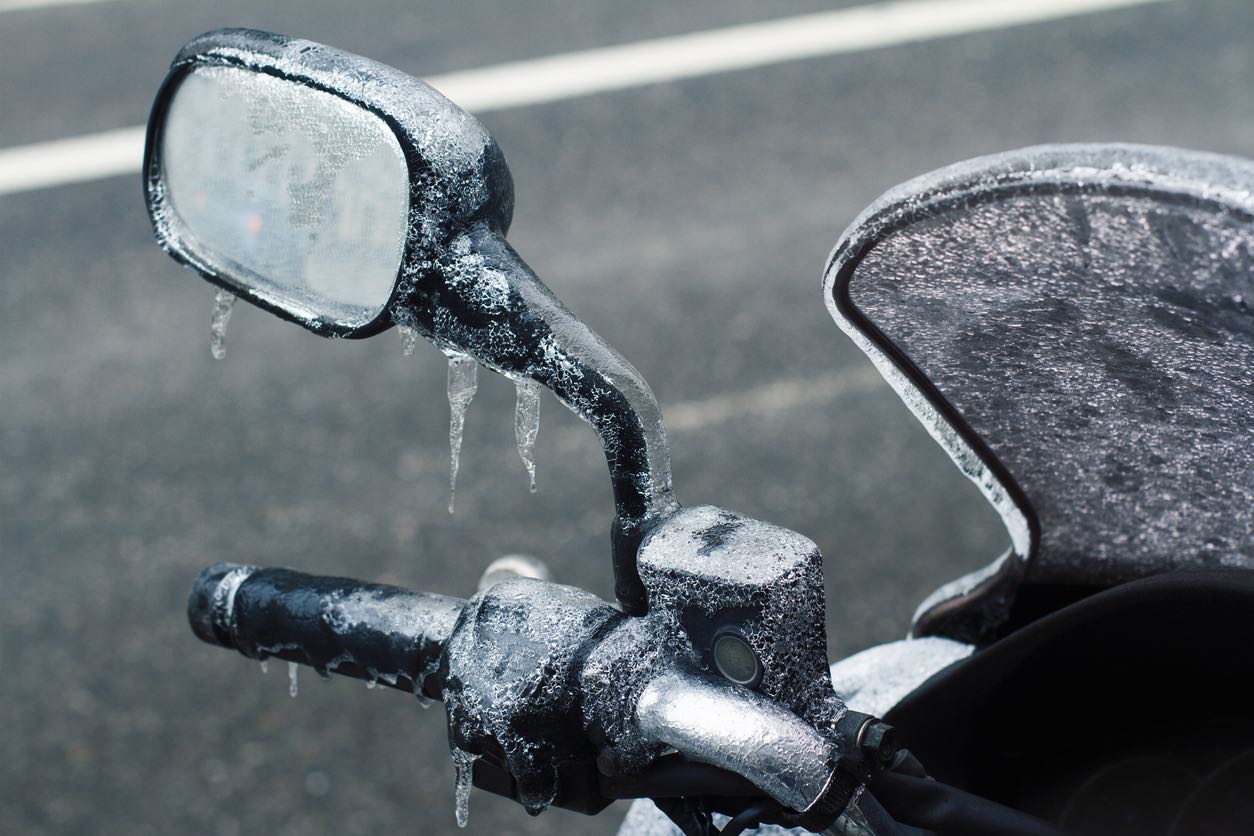
Battery Care During Hibernation
The battery is the electrical system’s central component and needs special attention in the off-season. In order to maintain the battery’s charge and general health, proper maintenance starts with disconnecting and storing it in a cool, dry location. It’s best to use a battery tender, also known as a trickle charger, as this keeps the battery charged at a steady level and keeps it from running out entirely. This strategy is essential because a completely depleted battery not only loses capacity but may also require expensive replacements in the spring.
To avoid unanticipated problems during storage, periodically check the battery’s condition in addition to these measures. This entails looking for any indications of corrosion or damage, which could be harmful to the device’s functionality. Insulating the battery can provide an additional layer of protection for people who live in particularly cold climates. Keep in mind that your motorcycle’s preparedness and dependability for your first spring ride are directly impacted by the work you put into keeping it’s battery healthy during the winter. Setting battery maintenance as a top priority guarantees that your motorcycle will be ready and eager to go when the roads call, emulating the spirit of unrestricted adventure.
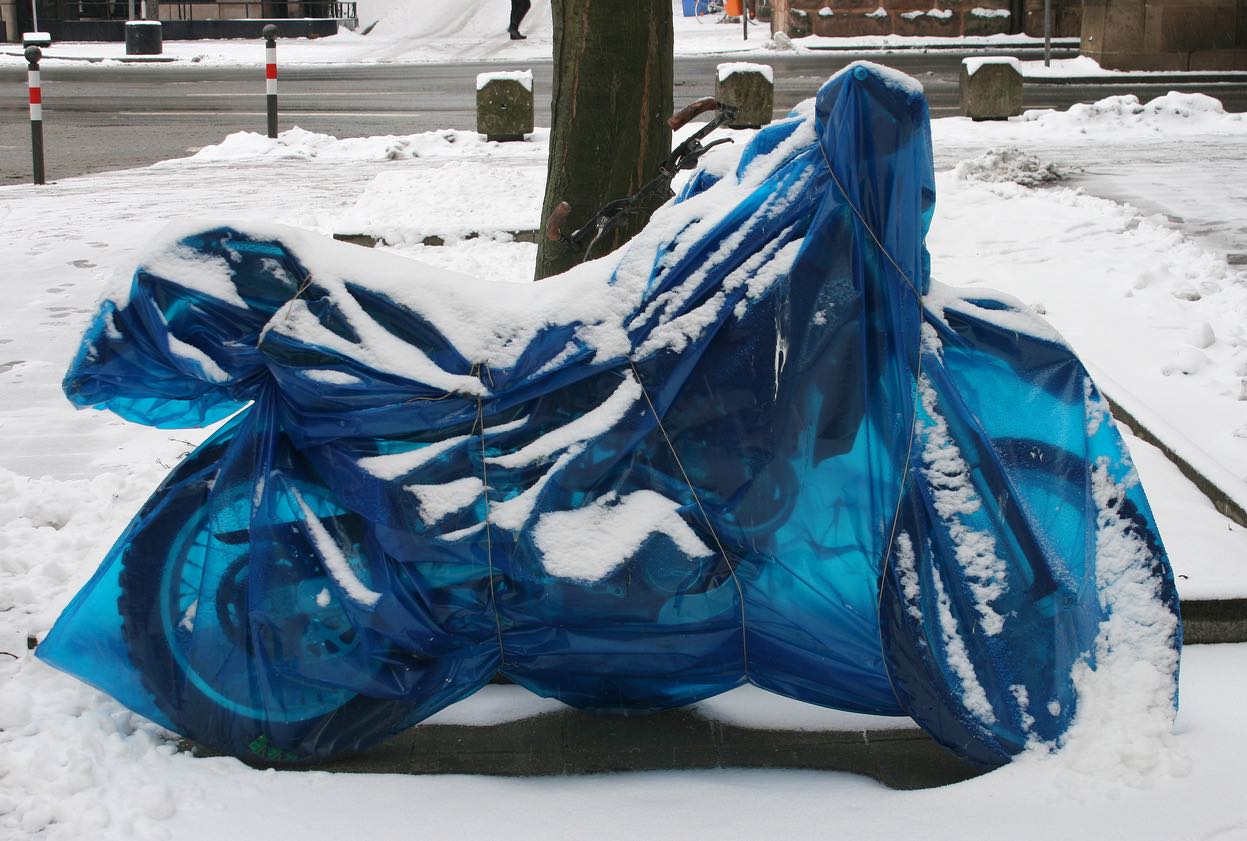
Preserving Tire Integrity
When getting your motorcycle ready for winter storage, a tire inspection is essential. Start by carefully inspecting the tires to look for wear indicators like cracks or thinning tread. This inspection is crucial since aging tires can jeopardize safety. Rubber can deteriorate more quickly in cold weather, so routine inspection and replacement (if needed) are essential. When you’re ready to get back on the road, your motorcycle will perform better thanks to well-maintained tires.
The best way to prevent flat spots, also known as tire deformation, while storing a motorcycle is to elevate it. When a stationary tire supports the weight of the vehicle for extended periods of time, it develops flat spots, which can cause uneven wear and potentially dangerous riding conditions. A good substitute for a lift or stand is to rotate the tires on a regular basis. This easy maneuver helps preserve the integrity and shape of the tire by redistributing the pressure. To ensure the smoothness and safety of your springtime rides, remember to give your tires the attention they need during the off-season. You can invest in the longevity and dependability of your beloved motorcycle by placing a high priority on tire health.
Ensuring Your Riding Gear is Ready for Spring
Just as much care should be taken with your riding apparel as your motorcycle. Regular cleaning and conditioning is recommended for leather items such as jackets, pants, gloves, and boots, particularly prior to storage. This preserves their suppleness and keeps the leather from drying out or cracking, keeping your rides comfortable and protected. Remember to wash textile items in accordance with the manufacturer’s instructions to get rid of dirt and grime from the road.
Helmet maintenance requires attention to detail. Cleaning the outside shell and the interior liner is essential. The majority of helmets include detachable liners for simpler cleaning; consult the instruction booklet for your particular helmet for details. To keep the helmet looking brand new, wipe down the outside with a mild cleaner after washing the liner. Furthermore, check your helmet for wear and damage; even small cracks can jeopardize safety.
As important as cleaning your equipment is storing it properly. To stop fading and deterioration, store leather goods away from direct sunlight in a cool, dry location. Helmets should be stored in a helmet box or bag to keep dust and unintentional bumps off of them. By providing your equipment with the maintenance it needs, you can make sure it stays in excellent shape, protecting you on your travels and getting you ready for the next riding season.
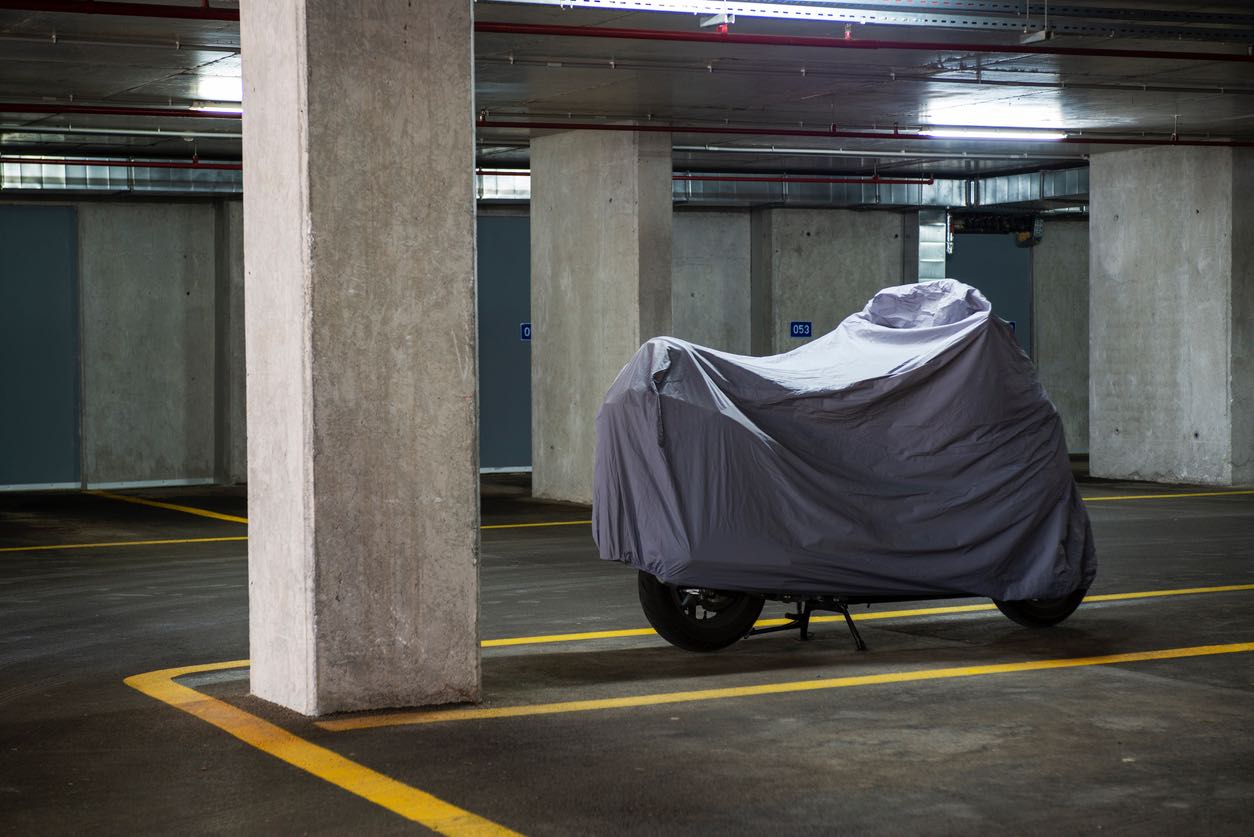
Finding the Right Spot for Your Motorcycle
Selecting a storage location is essential. It’s best to store things in a dry, safe place, like a shed, garage, or rented storage unit. If these choices aren’t available, think of inventive substitutes that will shield your bike from the weather. It is important to keep in mind that problems like rust and mold, which are caused by moisture, can seriously affect the state of your motorcycle.
The accessibility and security of the storage location should be taken into account in addition to a dry and safe environment. It’s important to have a location that is both accessible and safe from theft and vandalism. Looking into shared storage facilities or specialized motorcycle storage services can be a good idea for people who live in urban areas where space is at a premium. These establishments frequently offer climate-controlled spaces, which are perfect for storing motorcycles for an extended period of time. For peace of mind, give preference to such services that have strong security protocols and a happy customers.
Another important consideration for the storage location is temperature control. Temperature extremes—both hot and cold—can harm your motorcycle. It is best to find a place with a steady, moderate temperature. This aids in stopping the battery, rubber parts, and fluids from degrading. Thermal covers or other insulating materials can offer some degree of temperature stabilization if a climate-controlled environment is not an option, shielding your motorcycle from extreme temperatures.
You can do a great deal to protect your motorcycle’s condition and make sure it’s ready to ride again by carefully choosing the ideal storage location and making sure it satisfies all requirements for security, moisture control, and temperature stability.
Extra Protection for Your Motorcycle
Especially when storing your motorcycle for the winter, investing in a high-quality cover is essential to its longevity. A well-selected cover provides defense against unforeseen dings and scratches that can happen even in a garage or storage unit, in addition to shielding your motorcycle from dust and moisture. The best protection against condensation and outside factors comes from materials that are both breathable and long-lasting when choosing a cover. In order to avoid moisture accumulation, which can result in rust and other types of corrosion, a breathable cover is necessary.
Additionally, the correct motorcycle cover acts as a shield against UV rays and inclement weather, both of which can be especially damaging when storing a vehicle for an extended amount of time. A cover with UV protection and waterproof qualities becomes even more essential for outdoor storage situations. Keep in mind that the material of the cover is not as important as its fit. A cover made especially for your motorcycle model will fit snugly and reduce the likelihood that it will blow off or allow debris to get underneath. You can give your motorcycle the best care and protection by selecting a cover that fits it perfectly. This will keep your bike in perfect condition and ready to go when the weather turns.
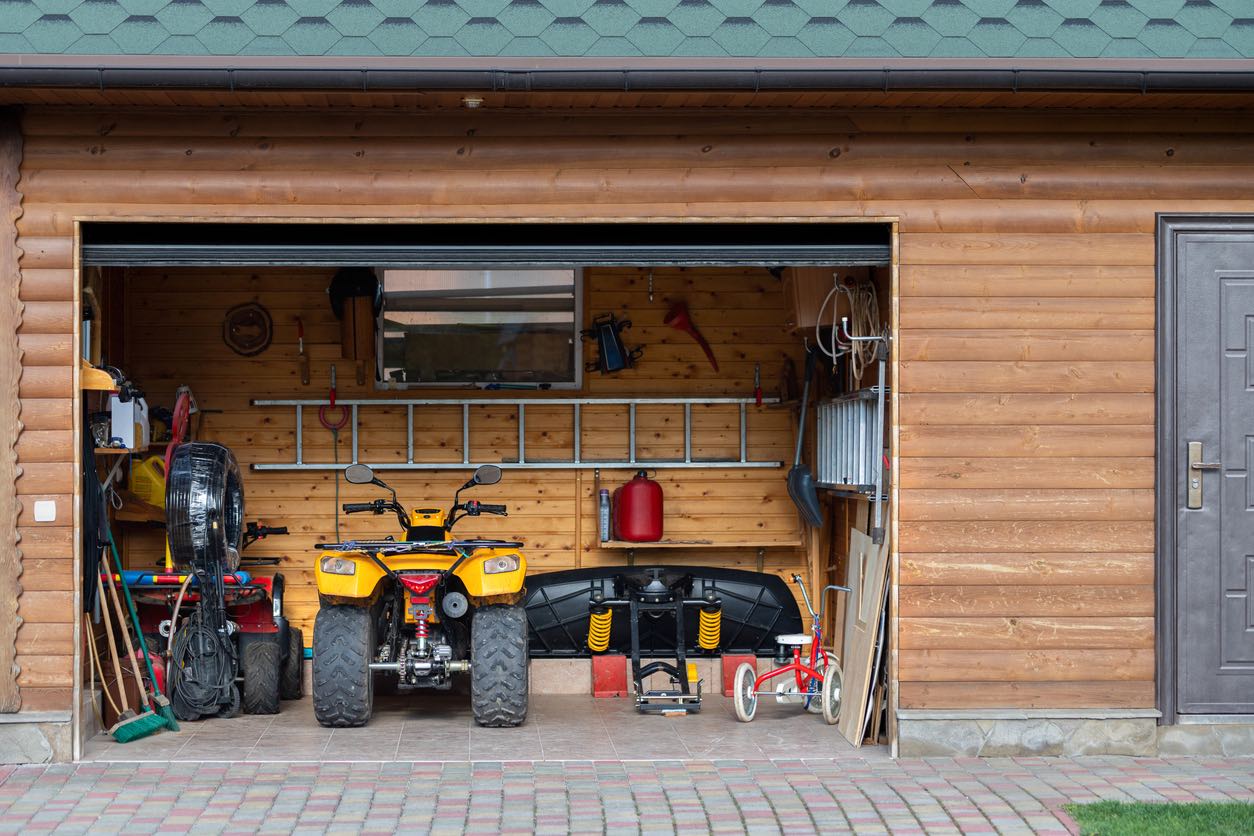
Avoiding Tire and Suspension Damage
One of the most important parts of keeping the motorcycle in good condition during the winter is to elevate it. This technique is especially helpful in avoiding suspension problems and tire deterioration. Raising the motorcycle off the ground helps to minimize the possibility of flat spots on the tires, which can occur when the bike is left stationary for extended periods of time. In addition to degrading the smoothness of your ride, flat spots can cause tires to wear down too soon and require expensive replacements. Raising your motorcycle also aids in maintaining the suspension parts. By keeping the bike off the ground, you can reduce the strain on the suspension system and keep it in top shape so you can get back on the roads when the weather gets warmer.
Paying close attention to the tires becomes even more important if there isn’t enough room or equipment to elevate the entire motorcycle. A good workaround is to rotate the tires on a regular basis. By distributing the motorcycle’s weight uniformly across the tire surface, this easy-to-do maneuver helps avoid flat spots from forming. Don’t forget to spend money on a high-quality motorcycle stand or lift. Not only are these tools helpful for winter storage, but they also help with year-round routine maintenance. Recall that the details of care and maintenance are what make a motorcycle last a lifetime; keeping your bike elevated during winter storage is a sign of your dedication to the longevity and functionality of your ride.
Winterizing your motorcycle is an essential ritual that you should follow to keep it in good working order and ready for the upcoming riding season. The detailed procedures in this guide, which cover everything from thorough cleaning and fluid checks to tire care, provide a barrier against winter’s harsh effects. These preventive steps become your motorcycle’s best line of defense against corrosion, dead batteries, and tire degradation as the temperature drops. By devoting time to these fundamental steps now, you can be sure that your motorcycle will not only survive but thrive and be prepared to travel with you on new adventures when the roads call again.
Winterizing your motorcycle is also a great way to get to know and understand it better. It’s an opportunity to examine every part, recognize the engineering feats, and develop a greater respect for the vehicle that has been your devoted traveling companion. By taking good care of your motorcycle’s storage, you’re honoring a bond forged over many miles and unforgettable experiences in addition to maintaining a vehicle. What separates the true enthusiasts from the casual riders is their dedication to appropriate winter storage. Your motorcycle will thank you for taking advantage of this season to care for and safeguard it with unmatched performance and dependability in the upcoming seasons.

It’s important to choose the right shipping company for your motorcycle, and Ship A Car, Inc. (SAC) is the best option for any motorcycle transport requirements. SAC is well-known for their unmatched dependability and proficiency in door-to-door motorcycle transportation throughout the United States. They ensure that the travel for your bike will be as easy and worry-free as the rides themselves. They treat every motorcycle as if it were their own, bringing an unparalleled level of care and professionalism to the table. From vintage bikes to the newest models, their knowledgeable staff takes meticulous care of every detail. For a free, no-obligation quote and to start your smooth motorcycle transport journey, give SAC a call at (866) 821-4555.
SAC is your go-to option whether you’re trading in your old bike for a new one, selling it, or shipping it to a warmer climate to avoid the winter cold. Their nationwide coverage guarantees that your motorcycle transport needs will be met with the highest priority for safety and promptness, regardless of where you are in the United States. With their door-to-door service, you can have convenience and peace of mind knowing that your motorcycle will be picked up and delivered exactly where you need it. Allow distance to not stand in the way of your motorcycle travels. Make the necessary arrangements with Ship A Car, Inc. to ensure that your bike is available whenever and wherever you need it.
Q: How frequently should I check on my motorcycle while it is being stored for the winter?
A: At regular intervals, it is recommended that you inspect your motorcycle to make certain that the battery tender is in good working order and that the cover is still in place effectively. In the event that the tires are not elevated, it is also recommended that they be rotated during these checks.
Q: If I do not have a garage, is it possible for me to store my motorcycle outside?
A: Certainly, but in order to shield it from the elements, it needs to be protected by a motorcycle cover that is sturdy, waterproof, and breathable. Additionally, it is essential to elevate the motorcycle and make certain that it is located in a safe and as dry a location as possible.
Q: Why is it essential to make use of a fuel stabilizer while the fuel is being stored?
A: As a result of the fuel stabilizer’s ability to prevent the gasoline from deteriorating and forming deposits that could potentially clog the fuel system, your motorcycle will be ready to run smoothly as soon as you remove it from storage.
